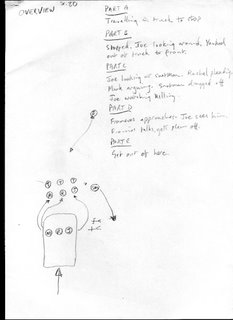The Roadblock Scene : Director's Notes, Shooting Set-Ups & Final Shots.
Scene 80 - Description
The school truck carries Joe and two TV journalists through the deserted Kigali streets towards the ETO. They are stopped at a roadblock, which is manned by Interahamwe militia, and the terrifying lawlessness of the genocide becomes apparent.
As a director, the first thing you need to do is figure out what it is you are trying to say with a scene. This does not mean dialogue. In its simplest form, every scene is a part of a larger story and it has to play its part in the furthering of that story. ALL scenes must fulfill that primary function with no exceptions.
In scene 80 there were 2 main aspects for me to consider: Character needs and story needs
A. One thread in the larger story was the emotional journey of Joe (Hugh Dancy) from wide-eyed idealist to guilt-ridden survivor. This scene was important in regard to his character because it marked the point in his journey that he crossed over into territory that was beyond his, or indeed anyone else’s, experience and comprehension.
B. This was a significant scene in terms of the audience’s knowledge of what was happening outside the confines of the ETO compound. The contrast had to be made between the atmosphere on the streets and the relative safety of the school. It was important to convey three things:
The idea that danger was omnipresent.
The casual and sudden unpredictability of violence.
To give that danger a face (as the Interahamwe turn up at ETO immediately after this)
Once you have decided what you want to say the next stage is working out HOW these ideas take physical form.
Shooting Sketches
In this sketch, Michael constructs a general overview of the structure of the roadblock scene. He has deconstructed the scene into 5 distinct sequences of action, Parts A-E. The diagram in the bottom-left corner fo the sketch describes the general movement of the characters within the scene.
Sketch No.2 : Parts A & B
. This sketch provides more detail about the individual shots that will make up Part A (the travelling of the truck along the dirt track) & Part B (the stopping of the truck where Joe and his fellow passengers are yanked out of the truck by the interahamwe).
This sketch provides more detail about the individual shots that will make up Part A (the travelling of the truck along the dirt track) & Part B (the stopping of the truck where Joe and his fellow passengers are yanked out of the truck by the interahamwe).
Each shot is listed in the column on the right-hand side whilst the diagrams on the left describe the movement of the characters along with the positioning and direction of the cameras.
By clicking on the link below, you can see how the final shots of each sequence came out.
Images form Part A
Images from Part B
This sketch provides a breakdown of each of the shots that will make up Part C (where tensions rise between Joe, Rachel, Mark and the interahamwe and where Joe witnesses a Tutsi murder at the roadside), and Part D/E (where Joe recognises one of the interahamwe and where Joe, Mark & Rachel eventually escape the situation.)
Again, each shot is numbered in the columns, and the movement of the characters and positioning/direction of the cameras is depicted in the diagrams.
Click on the links below to see how the final shots came out.
Images from Part C
Images from Part D/E
Tomorrow we will be posting comments from other cast & crew members about their personal experiences on shooting this particular scene.




6 Comments:
Are you chosing what to put on the Blog?. I wrote some analysis about the films lack of authenticity and this was not put on the blog. This is NOT the transparency and openess one would expect from the BBC
Why is the BBC telling a story that is fictitious on such a sentive subject. Details around genocide matter greatly.
How can the BBC be serious around education and voice with a rwandan survivors blogsite in english. This is not serious. This seens far too much about promotion than true solidarity and engagment. For too long survivors images and challenges have been abused for OTHER interests. The plight today is far too ignored.
The only comments removed from this site are adverts or comments that are offensive to other readers.
The Rwandan Survivors site is in English so it is accessible to a wide audience. The site was designed to be a voice for those survivors and also to raise the issues of genocide in the world today.
All the testimonials that are placed on the Rwandan Survivors blog are sent to us from Rwanda from actual survivors of the genocide. Not one testimonial has been edited or tampered with in any way. All the testimonials are sent to us in English.
I hope this answers your question.
Mileage always varies when it comes to the truth. Perhaps Mr. Anonymous should create his own blog site where he can share his understanding of the truth and allow this space to proceed with its perspective? Just a suggestion.
Myself, I find the glimpse into the makings of the film fascinating. Rarely is a filmgoer given such an opportunity. Thank you!! It will enrichen my appreciation of the film when I finally get to see it, whenever it's picked up by a US distributor. Hopefully soon, and in San Francisco!
Good design!
[url=http://flupiznj.com/fzfx/nosh.html]My homepage[/url] | [url=http://vywjmusb.com/hlam/qlxv.html]Cool site[/url]
Well done!
My homepage | Please visit
Good design!
http://flupiznj.com/fzfx/nosh.html | http://rvoujfzh.com/tqwi/woel.html
Post a Comment
<< Home